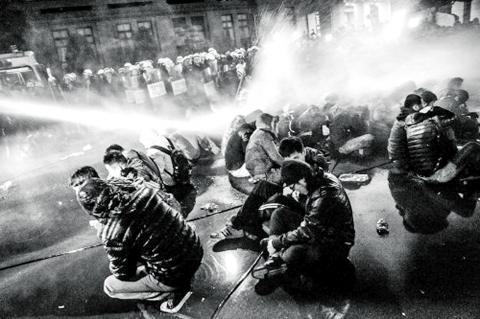Six months after the 24-day occupation of Legislative Yuan, Sunflower participants and supporters will return to the scene tonight — not to protest, but to watch Sunflower Occupation (太陽.不遠), a compilation of nine short documentaries that explore the multiple aspects of the movement and the various issues it raises.
Shortly after the students and activists occupied the legislative floor on March 18, the Taipei Documentary Filmmakers’ Union (台北市紀錄片從業人員職業工會) initiated the collective project and called on filmmakers to join. Eventually, 10 directors, 26 cinematographers and dozens of animators, editors, musicians and volunteers answered the call to create the standalone shorts, funded by 3,154 individual sponsors on VDemocracy.com, a crowdfunding platform for social movements.
Each work tackles a specific theme or issue. The Night of Enlightenment (一夜之間我長大), for example, brings viewers back to the night when the violent crackdown on students occupying the Executive Yuan left many wounded, disenchanted and politically enlightened. Student leader Chen Wei-ting (陳為廷) takes center stage in A Commander Made by Accident (不小心變成總指揮), which offers an honest portrait of Chen’s transformation as an activist. History is revisited in 1990 (我們的1990), revealing how Taiwan has gone through the Wild Lilies (野百合學運) student movement in 1991 to the Sunflowers, as seen through the eyes of former Wild Lilies.

Photo courtesy of Activator Marketing Company
Tonight’s event will take place on Jinan Road (濟南路) outside the legislature. The outdoor screening will start at 7pm, followed by a brief talk by two participating filmmakers He Chao-ti (賀照緹) and Tsai Tsung-lung (蔡崇隆).
After tonight’s screening, the film will tour to 17 cities and towns across the country from tomorrow to Nov. 16. All screenings are free. Those interested need to sign up through www.accupass.com, where screening schedules and venue information are available.
More information about the project can be found on its Facebook fan page at www.facebook.com/318doc.

April 7 to April 13 After spending over two years with the Republic of China (ROC) Army, A-Mei (阿美) boarded a ship in April 1947 bound for Taiwan. But instead of walking on board with his comrades, his roughly 5-tonne body was lifted using a cargo net. He wasn’t the only elephant; A-Lan (阿蘭) and A-Pei (阿沛) were also on board. The trio had been through hell since they’d been captured by the Japanese Army in Myanmar to transport supplies during World War II. The pachyderms were seized by the ROC New 1st Army’s 30th Division in January 1945, serving

The People’s Republic of China (PRC) last week offered us a glimpse of the violence it plans against Taiwan, with two days of blockade drills conducted around the nation and live-fire exercises not far away in the East China Sea. The PRC said it had practiced hitting “simulated targets of key ports and energy facilities.” Taiwan confirmed on Thursday that PRC Coast Guard ships were directed by the its Eastern Theater Command, meaning that they are assumed to be military assets in a confrontation. Because of this, the number of assets available to the PRC navy is far, far bigger

The 1990s were a turbulent time for the Chinese Nationalist Party’s (KMT) patronage factions. For a look at how they formed, check out the March 2 “Deep Dives.” In the boom years of the 1980s and 1990s the factions amassed fortunes from corruption, access to the levers of local government and prime access to property. They also moved into industries like construction and the gravel business, devastating river ecosystems while the governments they controlled looked the other way. By this period, the factions had largely carved out geographical feifdoms in the local jurisdictions the national KMT restrained them to. For example,

The remains of this Japanese-era trail designed to protect the camphor industry make for a scenic day-hike, a fascinating overnight hike or a challenging multi-day adventure Maolin District (茂林) in Kaohsiung is well known for beautiful roadside scenery, waterfalls, the annual butterfly migration and indigenous culture. A lesser known but worthwhile destination here lies along the very top of the valley: the Liugui Security Path (六龜警備道). This relic of the Japanese era once isolated the Maolin valley from the outside world but now serves to draw tourists in. The path originally ran for about 50km, but not all of this trail is still easily walkable. The nicest section for a simple day hike is the heavily trafficked southern section above Maolin and Wanshan (萬山) villages. Remains of